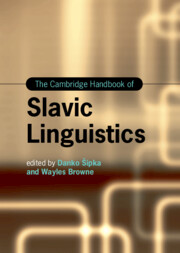Book contents
- The Cambridge Handbook of Slavic Linguistics
- Cambridge Handbooks in Language and Linguistics
- The Cambridge Handbook of Slavic Linguistics
- Copyright page
- Contents
- Figures
- Tables
- Contributors
- Introduction
- Part 1 Prosody and Phonology
- Part 2 Inflectional and Derivational Morphology
- 7 Inflectional Endings: Declensions
- 8 Inflectional Endings: Conjugation
- 9 Tense and Mood Forms
- 10 Aspect in Verbs
- 11 Lexical Derivation
- 12 Lexical Composition
- Part 3 Syntax
- Part 4 Lexicon
- Part 5 Sociolinguistic and Geographical Approaches
- Part 6 Experimental and Quantitative Approaches
- Name Index
- Subject Index
- References
9 - Tense and Mood Forms
from Part 2 - Inflectional and Derivational Morphology
Published online by Cambridge University Press: 16 May 2024
- The Cambridge Handbook of Slavic Linguistics
- Cambridge Handbooks in Language and Linguistics
- The Cambridge Handbook of Slavic Linguistics
- Copyright page
- Contents
- Figures
- Tables
- Contributors
- Introduction
- Part 1 Prosody and Phonology
- Part 2 Inflectional and Derivational Morphology
- 7 Inflectional Endings: Declensions
- 8 Inflectional Endings: Conjugation
- 9 Tense and Mood Forms
- 10 Aspect in Verbs
- 11 Lexical Derivation
- 12 Lexical Composition
- Part 3 Syntax
- Part 4 Lexicon
- Part 5 Sociolinguistic and Geographical Approaches
- Part 6 Experimental and Quantitative Approaches
- Name Index
- Subject Index
- References
Summary
This chapter provides an overview of the inventory, formation, and use of synthetic and periphrastic tense and mood forms in modern Belarusian, Bosnian/Croatian/Montenegrin/Serbian, Bulgarian, Czech, Macedonian, Polish, Russian, Slovak, Slovene, Lower and Upper Sorbian, and Ukrainian. It addresses both characteristics common to all modern languages and features of individual languages.
- Type
- Chapter
- Information
- The Cambridge Handbook of Slavic Linguistics , pp. 179 - 210Publisher: Cambridge University PressPrint publication year: 2024

